
IBM Doors: Is it the right time to transition from IBM DOORS?
- Modern Requirements
- April 23, 2025
- 9 minutes
Until the 1980s, organizations relied on tools such as Microsoft Word for requirements management. As product development processes became more complex, organizations realized the need for a requirements management tool that could track, manage, and maintain traceability across complex projects.
To solve this problem, QSS Ltd. launched the DOORS (Dynamic Object-Oriented Requirements System) software in the early 1990s. In 2008, IBM acquired this software and renamed it IBM DOORS.
However, the requirements management field is evolving at a fast pace. Traditional tools like IBM DOORS struggle to keep pace with modern software development practices.
In this blog, we will understand why IBM DOORS is not enough for requirements management, the security risks associated with the tool, and offer a full guide on selecting the right alternative.
Table of Contents
What is IBM DOORS?
IBM DOORS is a requirements management platform that helps organizations collect, track, analyze, and manage requirements. It is commonly used in regulatory industries, such as aerospace, finance, healthcare, etc., where traceability requirements are essential.

Key features of IBM DOORS are:
- Centralized Requirements Management: Offers a single repository to store, edit, and manage requirements.
- Bi-directional Traceability: Product teams can track requirements and connect them with dependencies.
- Version Control: Manage and track changes using the version control system.
- Collaboration and Access Control: Facilitates role-based structured access control, allowing multiple team members to work collaboratively.
- Test Tracking Toolkit: This lets you connect the requirements with test cases and results.
The drawbacks of IBM DOORS: Why users are frustrated
IBM DOORS has been a popular requirements management tool for three decades, but as project needs evolve, teams are struggling with its limitations.
Here are the main pain points identified through extensive user feedback and real-world experiences:
1. Complex installation
The installation of the IBM DOORS is not straightforward. It requires a desktop-based installation, along with server configuration for multi-user access. Organizations are required to get expert assistance for the setup and to monitor for issues in the future. This becomes a major hurdle for teams expecting a quick start or working in distributed environments.
One IBM user has raised a concern below about the complex installation process on G2.com.

2. Outdated user interface and poor usability
The outdated user interface of IBM DOORS is hard to navigate, which can reduce teams’ efficiency. For new users, it can be challenging to adopt the outdated UI.
Here is what Christian Wilmers says about the outdated IBM DOORS interface:

3. Performance and scalability issues
As the project scales and the database size or the number of team members increases, the performance of the tool slows down, or the system crashes.
One frustrated IBM DOORS user said, “A tool is slow, inconsistent, and breaks when you perform any simple act.”

4. Limited integration with modern development tools
Teams are often required to use the project management and requirements management tools together. IBM DOORS lacks built-in support to integrate with other tools. Due to this, teams can’t manage all project and requirements data in a single place.
5. High operational and maintenance costs
IBM DOORS is costly. First, organizations are required to pay fixed fees for the licensing and then continuous maintenance fees. Furthermore, teams are also required to hire professionals who can manage IBM DOORS, which adds an additional cost.
Here are a few responses from IBM DOORS users on PeerSpot.com sharing their experiences with the tool’s pricing and overall value.
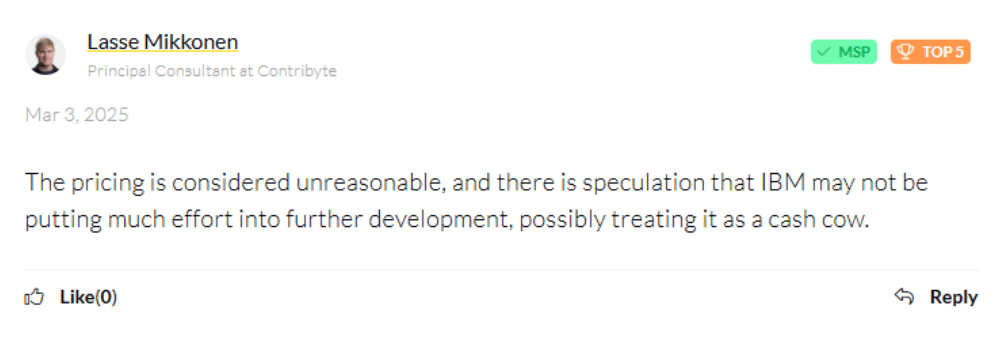
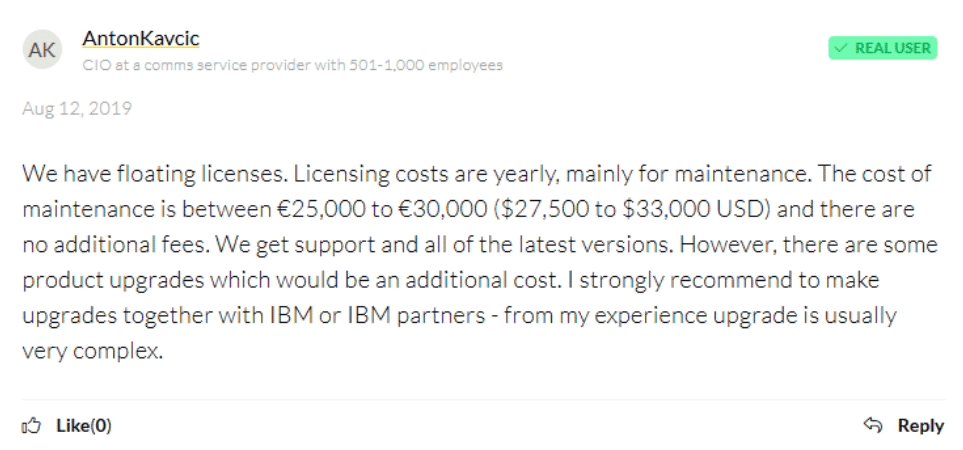
6. Not a Direct Upgrade to DOORS NG
The IBM DOORS NG is not a direct update of IBM DOORS. So, teams are required to perform data migration from IBM DOORS to DOORS NG and set all requirements configurations from scratch.
We came across an honest piece of feedback from an IBM DOORS user on Reddit:

7. Complex Migration Process
Users often complain that adopting a new requirements management tool and leaving behind IBM DOORS is complex. Migrating data from IBM DOORS to other platforms is a headache due to its proprietary data structures, often leading to vendor lock-in.
Even migrating data from IBM DOORS to DOORS NG is very complex.
Here is what the user has reported about the data migration issue:
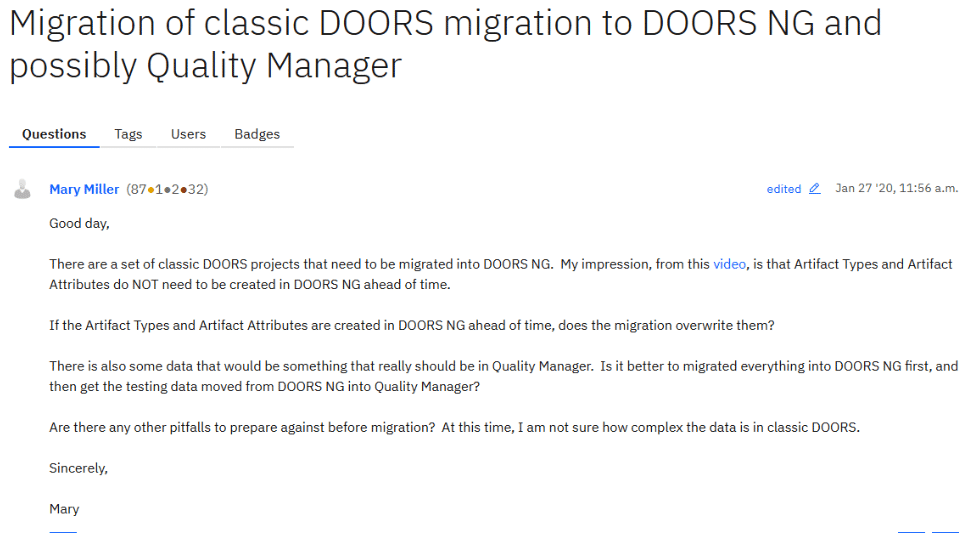
8. Security vulnerabilities raise concerns
IBM DOORS users have also expressed concerns about security gaps and vulnerabilities. These issues can pose risks for organizations handling sensitive or regulated data, especially when relying on legacy architectures.
A user on G2 reported:
“The software is not secure. There are vulnerabilities that can be exploited, and updates are too slow to patch them.”
These concerns are particularly important for teams working in industries like aerospace, healthcare, or defense, where security and compliance are non-negotiable.
9. Difficulty in collaboration
The lack of real-time collaborative features in IBM DOORS forces teams to rely on external tools for collaboration, causing fragmented communications and delays.
10. Compliance Risks
Outdated compliance tracking can make it hard to stay updated with regulatory standards, leading to legal consequences.
11. Limited Documentation Support
DOORS NG offers only basic functionalities to create requirements documents and prepare reports. It might be challenging to create and manage documents for complex projects.
How to choose the right alternative for requirements management
Selecting the right requirements management software can depend on your organization’s needs. Teams can consider the following factors while choosing the right alternative to the IBM DOORS:
- Cloud-Based & Scalable: Ensures the tool offers remote accessibility and scalability as the project grows.
- Seamless Integration: Connects easily with third-party project management tools like Azure DevOps.
- Ease of Use: Make sure the tool interface is easy to navigate and new team members can easily adopt it.
- Automated Traceability: Ensure that the tool offers traceability matrices to link requirements to work items of various phases of the product development lifecycle.
- Compliance & Audit Support: Helps meet industry regulations effortlessly.
- Advanced Features for Requirements Management: A tool must offer features to create documents and reports, perform impact assessments, etc.
- Cost-Effective & Low Maintenance: Reduces long-term operational expenses.
Azure DevOps + Modern Requirements: The future of requirements management
IBM DOORS no longer meets the needs of today’s fast-moving, complex product development environments. Its outdated structure makes it difficult for teams to stay efficient and aligned.
The good news? There’s a much better option available.
Modern Requirements4DevOps (MR4DevOps) is the most comprehensive requirements management solution built directly into Azure DevOps. MR4DevOps allows teams to manage requirements collaboratively, streamlining the overall requirements management workflow.
Key Features of Modern Requirements4DevOps
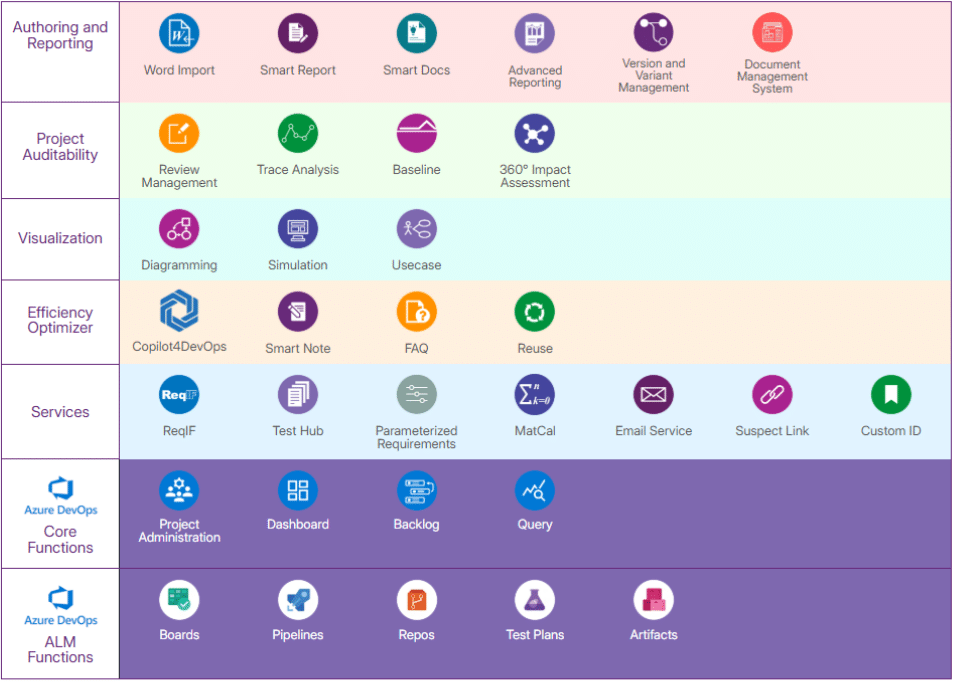
1. Solve documentation and reporting gaps
- Smart Docs: Offers a Microsoft Word-like interface to create and update requirements documents for Azure DevOps work items. It offers reusable meta templates, allowing teams to use a consistent structure across all documents.
- Smart Report & Advanced Reporting: Automates creating compliance and project reports.
- Version & Variant Management: Allows tracking and comparing all versions of requirements effortlessly.
- Document Management System: Keeps all requirements-related documents secure and in the related folders. Users can upload and download documents in different formats using the DMS.
2. Enhance auditability and compliance
- Review Management: Allows the creation of a review request for documents or work items and sends it to peers for review.
- Baseline Management: This module allows teams to track changes made while reviewing the product requirements.
- Trace Analysis & 360° Impact Assessment: Automatically creates traceability matrices to link requirements and perform the impact analysis to change any requirements.
3. Improve Visualization & Understanding
- Diagramming & Simulation: Visually map system workflows and behaviors.
- Use Case Modeling: Define, validate, and improve user interactions with structured diagrams.
4. AI capabilities
- Copilot4DevOps is an AI assistant for requirements management that is part of MR4DevOps.
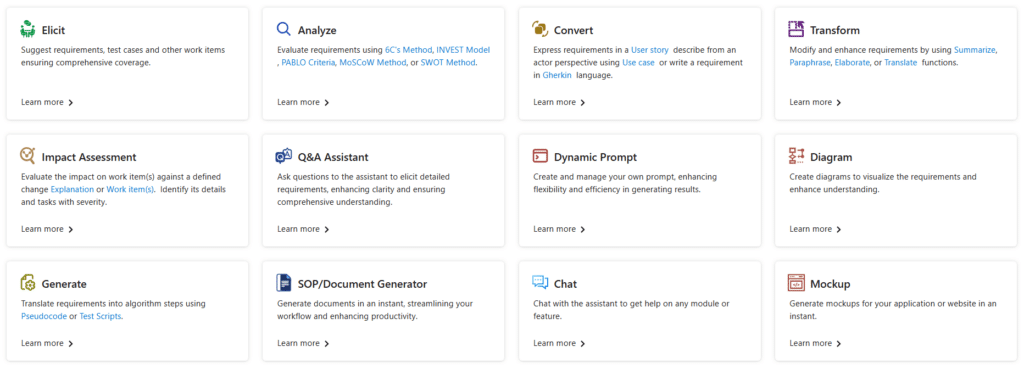
- Elicit requirements from raw input texts.
- Analyze requirements using AI.
- Perform impact assessment using AI.
- Write documents and reports by referencing work items.
- Generate test cases and test scripts.
- Automatically create no-code functional prototypes using the requirements description.
5. Automate and optimize requirements management
- FAQs: Allows for the transformation of answers in the format of the questions to generate FAQs.
- Smart Note: Offers an interface like OneNote to store free-style notes.
- Reuse Management: Save and repurpose frequently used requirements.
6. Service tools
- ReqIF: Exchange requirements between Azure DevOps and other ALM/PLM tools that support ReqIF (Requirements Interchange Format).
- Test Hub Reporting: Generate test reports and perform trace analysis.
- Parameterized Requirements: Allows teams to manage dynamic requirements.
- MatCal: Perform mathematical and logical calculations on work items to manage their relationships.
- Email Service: Convert emails into actionable work items.
Closing thoughts
IBM DOORS has been offering requirements management solutions for the last 30+ years. However, due to its outdated UI, complex data management, and high maintenance cost, teams often struggle with requirements management. While DOORS NG brings improvements, it still falls short when working on complex projects.
Teams should look for alternatives to IBM DOORS to overcome its challenges. Tools like Modern Requirements offer capabilities to manage requirements efficiently within the Azure workspace. It inherits security features from Azure DevOps that ensure an organization’s data is safe.
Now is the time to move beyond legacy systems and adopt a smarter, more efficient requirements management tool. Transition now!
Frequently Asked Questions (FAQs)
1. What is IBM DOORS used for?
IBM DOORS is used for requirements management. It allows teams to document and trace requirements and perform impact analysis. However, organizations are moving away due to limited functionalities and outdated UI.
2. How much does IBM DOORS cost?
The price of the IBM DOORS is not publicly available, as it depends on the licensing, number of users, and types of support required. However, organizations complain that it is expensive.
3. Why is Modern Requirements4DevOps the best alternative to IBM DOORS?
MR4DevOps offers advanced features like “Smart Docs”, “Smart Reporting”, version control, a diagramming tool, easy integration with Azure DevOps, etc., making it the organization’s go-to choice.
4. What is the price of MR4DevOps?
We offer dynamic pricing. You can contact our sales team to get quotes that match your needs.

